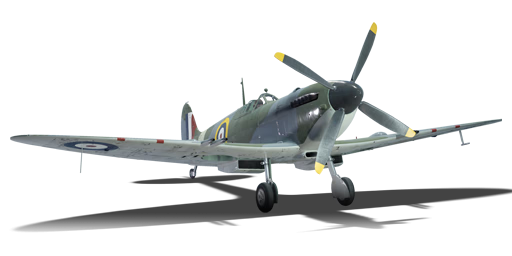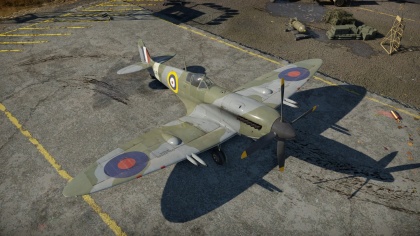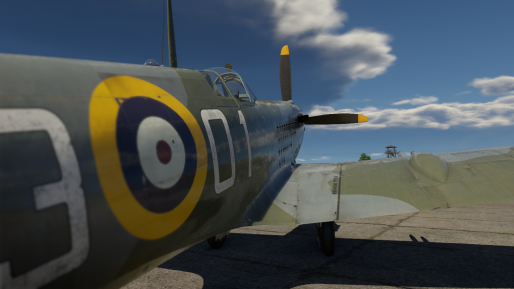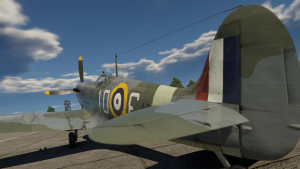Difference between revisions of "Spitfire F Mk IXc"
battalionier (talk | contribs) (→History) (Tag: Visual edit) |
battalionier (talk | contribs) (→History) (Tag: Visual edit) |
||
| Line 225: | Line 225: | ||
== History == | == History == | ||
| − | The Spitfire IX was the result of combining Spitfire Mk V airframe with a Rolls-Royce Merlin 61 or 63. | + | The Spitfire IX was the result of combining Spitfire Mk V airframe with a Rolls-Royce Merlin 61 or 63. It was conceived as a temporary response to the Focke-Wulf 190 while production of the improved Spitfire Mk VIII airframe was ramping up. Early models of the Spitfire IX were equipped with what was known as the “c” wing. The “c” wing was designed to decrease production cost and time when compared to the “a” and “b” wing while allowing for use of universal armament installation giving it the nomenclature of the universal wing. The “c” wing was capable of equipping 8 browning 303 machine guns, 2 Hispano 20 millimeter autocannons and browning 303 machine guns, or 4 Hispano 20 millimeter autocannons. The most common configuration was that of 2 Hispano 20 millimeter autocannons and browning 303 machine guns the reason for this is that the equipping the wing with 4 Hispano 20 millimeter autocannons resulted in technical problems which could cause the guns to malfunction at high altitude.[http://spitfiresite.com/2010/04/spitfire-the-hispano-cannon.html <nowiki>[2]</nowiki>] Later models of Mk VIII were equipped with the “e” type wing which was a slightly improved version of the “c” type that allowed for the installation of 2 browning 50 caliber machine guns and 2 Hispano 20 millimeter autocannons. |
== Media == | == Media == | ||
Revision as of 08:26, 22 December 2020
Contents
| This page is about the British aircraft Spitfire F Mk IXc. For other vehicles of the same family, see Spitfire (Family). |
Description
The Spitfire F Mk IXc is a rank III gift British fighter
with a battle rating of 5.0 (AB) and 4.7 (RB/SB). This aircraft was introduced in Update 1.77 "Advancing Storm" as a reward during Royal Air Force centenary.
General info
Flight Performance
Describe how the aircraft behaves in the air. Speed, manoeuvrability, acceleration and allowable loads - these are the most important characteristics of the vehicle.
| Characteristics | Max Speed (km/h at 8,537 m) |
Max altitude (metres) |
Turn time (seconds) |
Rate of climb (metres/second) |
Take-off run (metres) | |||
|---|---|---|---|---|---|---|---|---|
| AB | RB | AB | RB | AB | RB | |||
| Stock | 618 | 602 | 11500 | 18.1 | 18.8 | 15.3 | 15.3 | 380 |
| Upgraded | 669 | 642 | 16.3 | 17.2 | 23.7 | 18.9 | ||
Details
| Features | ||||
|---|---|---|---|---|
| Combat flaps | Take-off flaps | Landing flaps | Air brakes | Arrestor gear |
| X | X | ✓ | X | X |
| Limits | ||||||
|---|---|---|---|---|---|---|
| Wings (km/h) | Gear (km/h) | Flaps (km/h) | Max Static G | |||
| Combat | Take-off | Landing | + | - | ||
| 774 | 270 | N/A | N/A | 230 | ~12 | ~7 |
| Optimal velocities (km/h) | |||
|---|---|---|---|
| Ailerons | Rudder | Elevators | Radiator |
| < 321 | < 400 | < 350 | > 450 |
| Compressor (RB/SB) | ||
|---|---|---|
| Setting 1 | ||
| Optimal altitude | 100% Engine power | WEP Engine power |
| 4,200 m | 1,330 hp | 1,543 hp |
| Setting 2 | ||
| Optimal altitude | 100% Engine power | WEP Engine power |
| 7,500 m | 1,150 hp | 1,334 hp |
Survivability and armour
- 38 mm Bulletproof glass in front of the pilot
- 3 mm Steel plate on top of fuel tanks
- 4 mm Steel plate on pilot's seat. Behind pilot is another 6-7 mm steel plate
- 3 mm Steel plates around ammunition
- Critical components located at the front of aircraft (fuel, pilot, engine, controls)
- Liquid cooling system at the wing root
Armaments
Offensive armament
The Spitfire F Mk IXc is armed with:
- 4 x 20 mm Hispano Mk.II cannon, wing-mounted (120 rpg = 480 total)
Suspended armament
The Spitfire F Mk IXc can be outfitted with the following ordinance:
- Without load
- 1 x G.P. 250 lb Mk.IV bomb
Usage in battles
Describe the tactics of playing in an aircraft, the features of using vehicles in a team and advice on tactics. Refrain from creating a "guide" - do not impose a single point of view, but instead, give the reader food for thought. Examine the most dangerous enemies and give recommendations on fighting them. If necessary, note the specifics of the game in different modes (AB, RB, SB).
Manual Engine Control
| MEC elements | ||||||
|---|---|---|---|---|---|---|
| Mixer | Pitch | Radiator | Supercharger | Turbocharger | ||
| Oil | Water | Type | ||||
| Controllable | Controllable | Not controllable | Controllable
Auto control available |
Combined | Controllable | Not controllable |
Modules
| Tier | Flight performance | Survivability | Weaponry | ||
|---|---|---|---|---|---|
| I | Fuselage repair | Radiator | Offensive 20mm | ||
| II | Compressor | Airframe | New 20mm cannons | ||
| III | Wings repair | Engine | Mk.II Year 1942 | SBC mark 25 | |
| IV | Engine injection | Cover | Mk.II Year 1943 | ||
| This is a premium vehicle: all modifications are unlocked on purchase | |||||
Pros and cons
Pros:
- Significantly increased firepower compared to the regular Spitfire F. Mk IX at a minimal performance cost
- Ammunition pool boost to 120 rounds per gun compared to the 60 rounds of predecessors
- Good low altitude performance
- Highly manoeuvrable and excellent roll rate
- Good climb rate
- Very good at Boom and Zoom
- Engine (fuel injected) will not shut off performing a quick Negative G manoeuvre unlike the Spitfires before it (RB/SB)
Cons:
- Poor acceleration and rate of climb at high altitude
- Heavy recoil when firing, although can be negated by tap firing
- Mediocre energy retention in sharp turns
- Only one flap setting (landing), and the ripping speed is really low
- Ammunition pool is easy to burn out without trigger discipline
- Hispanos overheat and jam quickly
- Light airframe, which can't withstand a lot of punishment
- Suffers heavily from compression in steep dives
- A leak in the cooling system can cripple the engine in minutes
History
The Spitfire IX was the result of combining Spitfire Mk V airframe with a Rolls-Royce Merlin 61 or 63. It was conceived as a temporary response to the Focke-Wulf 190 while production of the improved Spitfire Mk VIII airframe was ramping up. Early models of the Spitfire IX were equipped with what was known as the “c” wing. The “c” wing was designed to decrease production cost and time when compared to the “a” and “b” wing while allowing for use of universal armament installation giving it the nomenclature of the universal wing. The “c” wing was capable of equipping 8 browning 303 machine guns, 2 Hispano 20 millimeter autocannons and browning 303 machine guns, or 4 Hispano 20 millimeter autocannons. The most common configuration was that of 2 Hispano 20 millimeter autocannons and browning 303 machine guns the reason for this is that the equipping the wing with 4 Hispano 20 millimeter autocannons resulted in technical problems which could cause the guns to malfunction at high altitude.[2] Later models of Mk VIII were equipped with the “e” type wing which was a slightly improved version of the “c” type that allowed for the installation of 2 browning 50 caliber machine guns and 2 Hispano 20 millimeter autocannons.
Media
See also
Links to the articles on the War Thunder Wiki that you think will be useful for the reader, for example:
- reference to the series of the aircraft;
- links to approximate analogues of other nations and research trees.
External links
Paste links to sources and external resources, such as:
- topic on the official game forum;
- encyclopedia page on the aircraft;
- other literature.
| Supermarine | |
|---|---|
| Spitfires | |
| Merlin engine | Spitfire Mk Ia · Spitfire Mk IIa · Spitfire Mk.IIa Venture I · Spitfire Mk IIb |
| Spitfire Mk Vb · Spitfire Mk Vb/trop · Spitfire Mk Vc · Spitfire Mk Vc/trop | |
| Spitfire F Mk IX · Spitfire F Mk IXc · Spitfire F Mk XVI | |
| Spitfire LF Mk IX · Plagis' Spitfire LF Mk IXc | |
| Griffon engine | Spitfire F Mk XIVc · Spitfire F Mk XIVe · Prendergast's Spitfire FR Mk XIVe · Spitfire F Mk XVIIIe · Spitfire F Mk 22 · Spitfire F Mk 24 |
| Export | ▄Spitfire Mk Vb/trop · ▃Spitfire LF Mk IXc · ▂Spitfire Mk IXc · Spitfire Mk IXc · Spitfire Mk.IX (CW) · Weizman's Spitfire LF Mk.IXe · ▄Spitfire FR Mk XIVe |
| Seafires | Seafire LF Mk.III · Seafire F Mk XVII · Seafire FR 47 |
| Export | ▄Seafire LF Mk.III |
| Jet fighters | Attacker FB 1 · Attacker FB.2 · Scimitar F Mk.1 · Swift F.1 · Swift F.7 |
| Hydroplanes | Walrus Mk.I |
| Britain premium aircraft | |
|---|---|
| Fighters | Tuck's Gladiator Mk II · ▄Boomerang Mk I · ▄Boomerang Mk II · ▄D.520 |
| ▄Martlet Mk IV · ▄Corsair F Mk II · ▄Hellcat Mk II · ▄Thunderbolt Mk.1 · ▄Mustang Mk IA | |
| Hurricane Mk.I/L FAA M · Spitfire Mk.IIa Venture I · Spitfire F Mk IXc · Plagis' Spitfire LF Mk IXc · Spitfire F Mk XIVc · Prendergast's Spitfire FR Mk XIVe | |
| Typhoon Mk Ib · MB.5 | |
| Twin-engine fighters | Hornet Mk.I · Whirlwind P.9 |
| Jet fighters | Attacker FB.2 · Hunter FGA.9 · Lightning F.53 · Meteor F Mk.8 Reaper · Sea Vixen F.A.W. Mk.2 · F-4J(UK) Phantom II · ▄MiG-21 Bison |
| Strike aircraft | ▄Wirraway · Beaufighter Mk I (40-mm) · Wyvern S4 |
| Harrier GR.1 · Strikemaster Mk.88 | |
| Bombers | ▄Avenger Mk II · ▄Boston Mk I · ▄Catalina Mk IIIa · ▄DB-7 · ▄Havoc Mk I · ▄Hudson Mk V · Swordfish Mk II |







